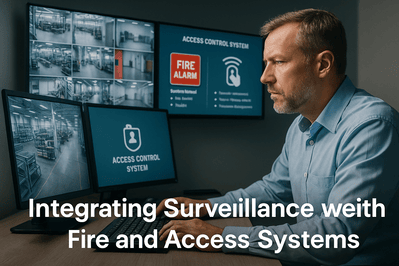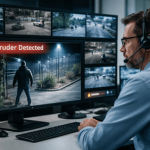
In a manufacturing facility, seconds matter.
A fire alarm blares. Workers scatter. A side door opens unexpectedly. A surveillance operator scans the feed, unsure whether it’s a real emergency or a drill. Meanwhile, leadership has no immediate visibility into what's happening or whether everyone is accounted for.
This is where disconnected safety systems fall short.
Surveillance, access control, and fire systems have traditionally operated in silos—each effective on its own, but limited when not integrated. In today’s high-risk, high-compliance manufacturing environments, an incident demands real-time coordination.
This article explores how integrating these systems creates a 360° safety ecosystem—one that improves incident response, reduces downtime, and protects both people and property.
k
k
🔥 The Problem: Safety Systems Working in Silos
Most manufacturing plants still rely on standalone platforms:
-
Fire alarm systems trigger building-wide sirens, but don’t alert access control or security cameras.
-
Cameras record continuously, but don’t actively respond to specific alarm events.
-
Access control may log door openings but can’t distinguish between a panic response and a badge swipe.
When these systems don’t communicate, teams must manually investigate, losing precious minutes and potentially making the wrong call.
k
k
🔄 What Integration Looks Like in Action
A truly integrated security ecosystem synchronizes detection, video verification, and physical response in real time.
🔗 Here’s how it works:
-
Fire Alarm Activation
→ Instantly triggers camera bookmarks for incident zones
→ Unlocks designated emergency exit doors
→ Sends live video to safety officers and command center
→ Notifies access control system to disable standard badge rules -
Access Door Forced Open During Emergency
→ Automatically flags the event
→ Camera pivots (PTZ) to that door
→ Operator or AI verifies the event in real time -
Duress Button or Panic Station Activated
→ Alerts both surveillance and access systems
→ Records incident with timestamp and door activity
→ Can initiate lockdown or partial lockdown sequences
k
k
🧠 Why Integration Is Crucial in Manufacturing Environments
✅ 1. Speeds Up Emergency Response
When seconds count, integration eliminates delays between alert and action. Cameras automatically focus on alarm points. Emergency doors release instantly. First responders get accurate, real-time situational awareness.
✅ 2. Reduces Human Error
Manual coordination between systems is prone to oversight. Integration allows pre-defined automation—reducing the chance of a missed door lock, a late notification, or a delayed evacuation.
✅ 3. Provides Contextual Awareness
Surveillance alone can’t confirm why a door opened. A fire panel alone can’t verify if the alarm is false. But together, they provide full context to help security teams respond appropriately.
✅ 4. Improves Compliance and Audit Readiness
Regulations often require verifiable incident logs, including access records, evacuation details, and surveillance footage. Integrated systems automatically compile and timestamp all relevant data in one place.
✅ 5. Supports Scalable Facility Growth
As your operations grow—new lines, new buildings, more staff—an integrated system scales with you, providing a consistent safety infrastructure across every location.
k
k
🛠️ Key Technologies that Enable Integration
If you're planning to move from siloed systems to a unified safety strategy, consider these tools:
-
Video Management Systems (VMS) that support event-based recording and API integrations
-
Cloud-based Access Control that can automate rules based on fire or duress events
-
Fire Panel Interfaces that trigger logic-based outputs
-
Mass Notification Platforms that sync with access and surveillance alerts
-
AI-enabled Surveillance Cameras that detect smoke, movement patterns, or unauthorized access
k
k
🏭 Real-World Use Case: Chemical Manufacturing Plant
Challenge:
Frequent fire drills and occasional system glitches caused confusion, as camera footage had to be manually reviewed and access logs pulled separately. Door overrides weren’t always applied correctly, posing safety and compliance risks.
Solution:
The plant integrated:
-
Fire panel with access control
-
Surveillance VMS with fire zones
-
Emergency notification system with mobile alerts
Outcome:
-
75% faster incident verification
-
100% door compliance during drills and real events
-
Simplified OSHA and insurance audits with unified incident reports
k
k
🔐 How SSP Helps Manufacturers Achieve 360° Safety
SSP specializes in designing fully integrated safety ecosystems for manufacturing environments. Our approach includes:
-
Assessing existing fire, access, and video infrastructure
-
Designing intelligent trigger logic and system automation
-
Implementing real-time notifications and event tracking
-
Ensuring all components are code-compliant and audit-ready
Whether you're upgrading a single system or transforming your full safety strategy, we help connect the dots.
kk
k
🏁 Final Thoughts: Don’t Just Detect—Respond Intelligently
In today’s fast-paced manufacturing world, information without coordination is not enough.
By integrating your surveillance, access control, and fire systems, you move from reactive to proactive—from confused to coordinated.
👉 Want a safety systems integration plan built around your facility?


